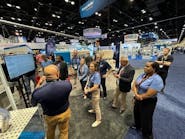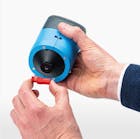By David Tillett
Implementing traditional vision systems requires a level of sophistication that can be daunting for most manufacturers, said Brian Benoit, a senior product manager with Cognex Corp.
“Typically, it requires three different systems to kind of come together and work together in order to get to deployment,” he said. “So you have to find a camera that’s got the right lighting and the right field of view; you have to find a piece of software you'll be able to use in order to do whatever application you're trying to solve; and then you need to spec out a piece of hardware, a PC that has a powerful GPU. So it's a pretty steep barrier.”
Benoit contrasted that with Cognex’s In-Sight D900 smart camera vision system, which launched in 2020. “All three of those things are in one platform,” he said. “So it's much easier to get from image acquisition to deployment, because all of that is embedded in the same product.”
Benoit said that while deep learning software for vision systems goes back approximately the last three or four years, turnkey products that allow a user to buy a single piece of hardware, set it up themselves and begin inspecting parts haven’t been around long. “As far as a true, fully capable deep learning product — it's fairly new that you're seeing these products come to market.”
“The D900 is a product that's bringing really complex deep learning applications into a much broader audience, because it's being developed in kind of a point-and-click GUI interface,” rather than requiring in-depth programming skills, Benoit said.
The D900 incorporates the company’s In-Sight ViDi software to offer embedded deep learning capabilities without the need for a PC. Its lighting, lenses, filters and covers can be changed on site, and it is available in monochrome and color models with resolutions of 2.3 megapixels or 5 megapixels.
Benoit identified three main applications for the D900: defect detection, optical character recognition and verification of assembly.
As an example of defect detection that the D900 can be used for, Benoit pointed to flash on molded plastic parts. “That flash could be incredibly variable from one to the next in size and location, even in the way that the camera interacts with it from a lighting perspective.” Defect detection could also include things like scratches or deformation of the product.
“Deep learning is a is an excellent solution for that, because it can adapt to much more variability than you would with kind of a standard vision [system],” Benoit said.
Benoit said the D900 can handle character recognition tasks even when there are variations in the printing — such as deformed, skewed or poorly etched codes — and lighting of the parts it is inspecting. Assembly verification can include both complex finished parts and products such as medical kits that require multiple components to be arranged correctly.
Benoit said that Cognex offers two kinds of deep learning approaches to part inspection: Unsupervised training, where a user uploads a range of images of good parts, and based on that information the system will flag defective parts. Benoit said anywhere between 50 and 300 images of good parts are typically needed to begin inspection.
In supervised mode, the user identifies the defects in a part by labeling them to help teach the system.
The parts themselves, as well as a customer’s need to track defect categories, will guide which approach they choose.
“It depends greatly on how different your parts are from one to the next, how much variation you can expect in the world of ‘good,’ ” Benoit said. “And then the other piece to that is … if you're using a supervised mode, you can classify the type of defect afterwards … You can say, ‘Find the defect, but also tell me is that defect a scratch? Is it a dent? Is it a smudge?’ ... So not only will it identify whether there is a defect present, it'll also tell you where it is.”
“So again, it varies greatly, like the most simple applications you can do in this unsupervised mode, where you're only showing it good images all the way down to much more complex applications, where you're finding it, locating it, and then classifying it,” he said.
For more metric-driven needs, Benoit pointed to Cognex’s In-Sight 3D-L4000, a 3-D vision system that uses a blue laser and camera to handle very accurate measurement and inspection tasks on automated production lines.
The L4000’s blue laser allows it to capture higher-quality, speckle-free images than traditional systems. “It's a new piece of hardware, where we're doing all of the processing on an embedded camera,” Benoit said. The L4000 runs the same software as the D900, and he said that coupled with its intuitive point-and-click spreadsheet makes it easy to learn and train with. “Again, we're taking some very complicated and sophisticated 3-D tools, and delivering them into many more users’ hands through our spreadsheet kind of GUI interface,” he said.
It can be used for a wide variety of tasks, from checking geometries, gap measurements and plane angles of parts to inspecting fill levels, verifying containers’ caps are properly sealed and conducting packaging quality inspection.
“And so now you're … bringing a really powerful piece of technology into a much broader market – and in terms of who can use it, and who can get it deployed,” he said.
Looking ahead at trends of the near future, Benoit said one of the developing needs for customers that begin collecting inspection data where it didn’t exist before is to go beyond using it for the immediate task of deciding pass/fail for individual parts, and to be able to collect and use that data to identify trends.
“It's moving beyond that single point of inspection, but also not just dumping it in some folder somewhere, so that someone else has to go in and kind of mine all that data; that's not going to be very helpful either,” he said. “So it's pulling it together, archiving it, but also presenting it to the user in a kind of a user-friendly dashboard, that's going to make sense to them. And so, it's all of that kind of coming together to deliver some potential, more advanced analytics to improve yield or uptime … whatever the customer cares about.”
“And so that's, I think, an area where we're going to be focusing a bit of our attention over the next 12 to 18 months,” Benoit said.
David Tillett, associate editor
Contact:
Cognex Corp., Natick, Mass., 855-426-4639, www.cognex.com






